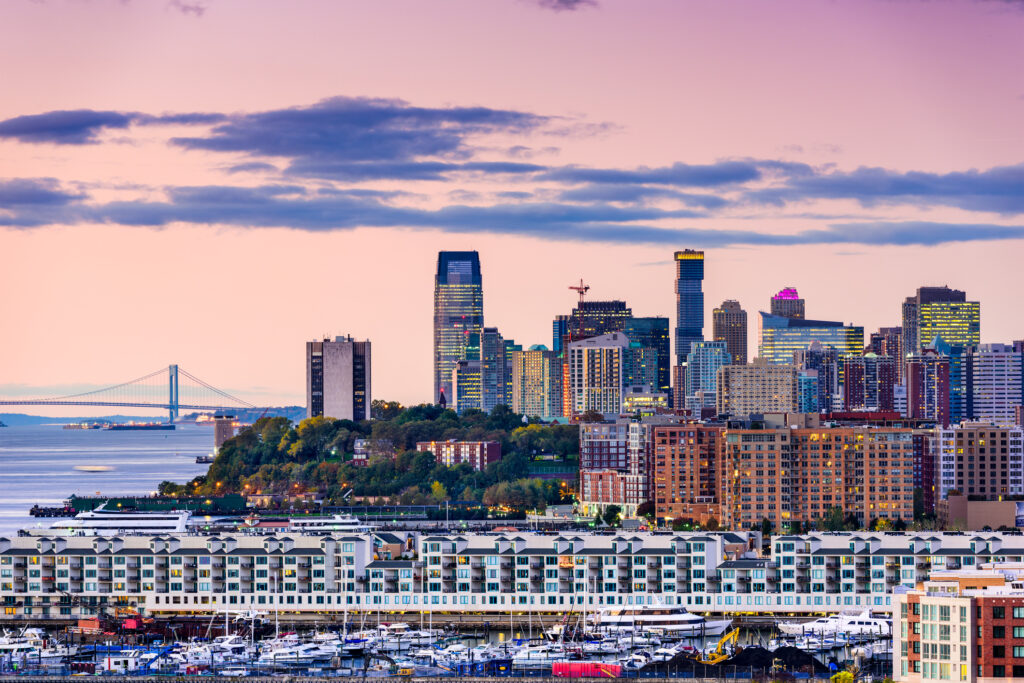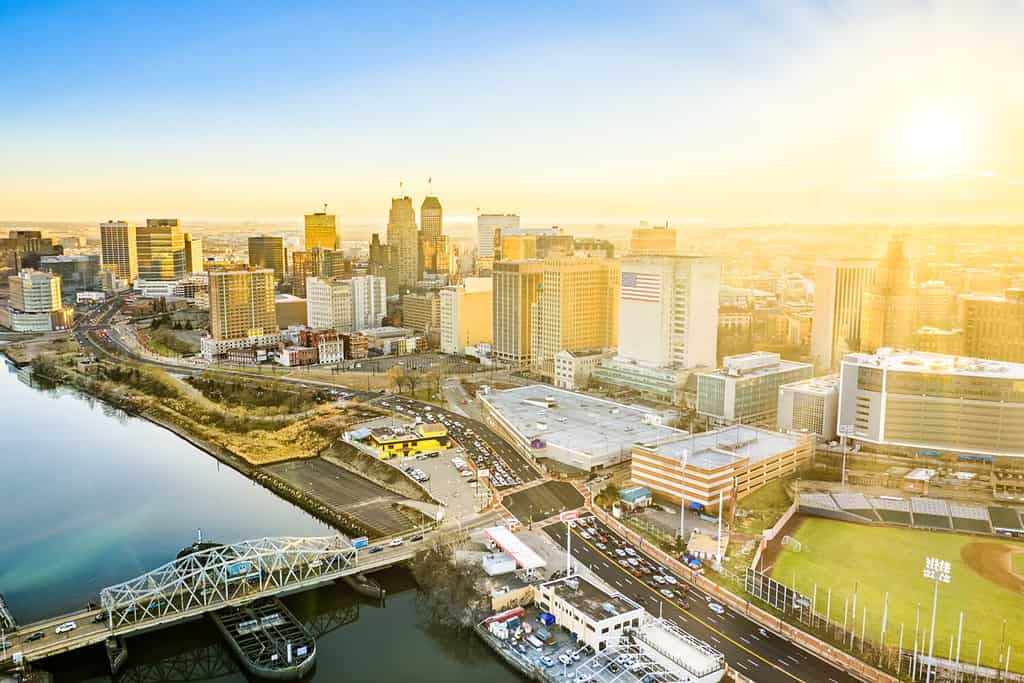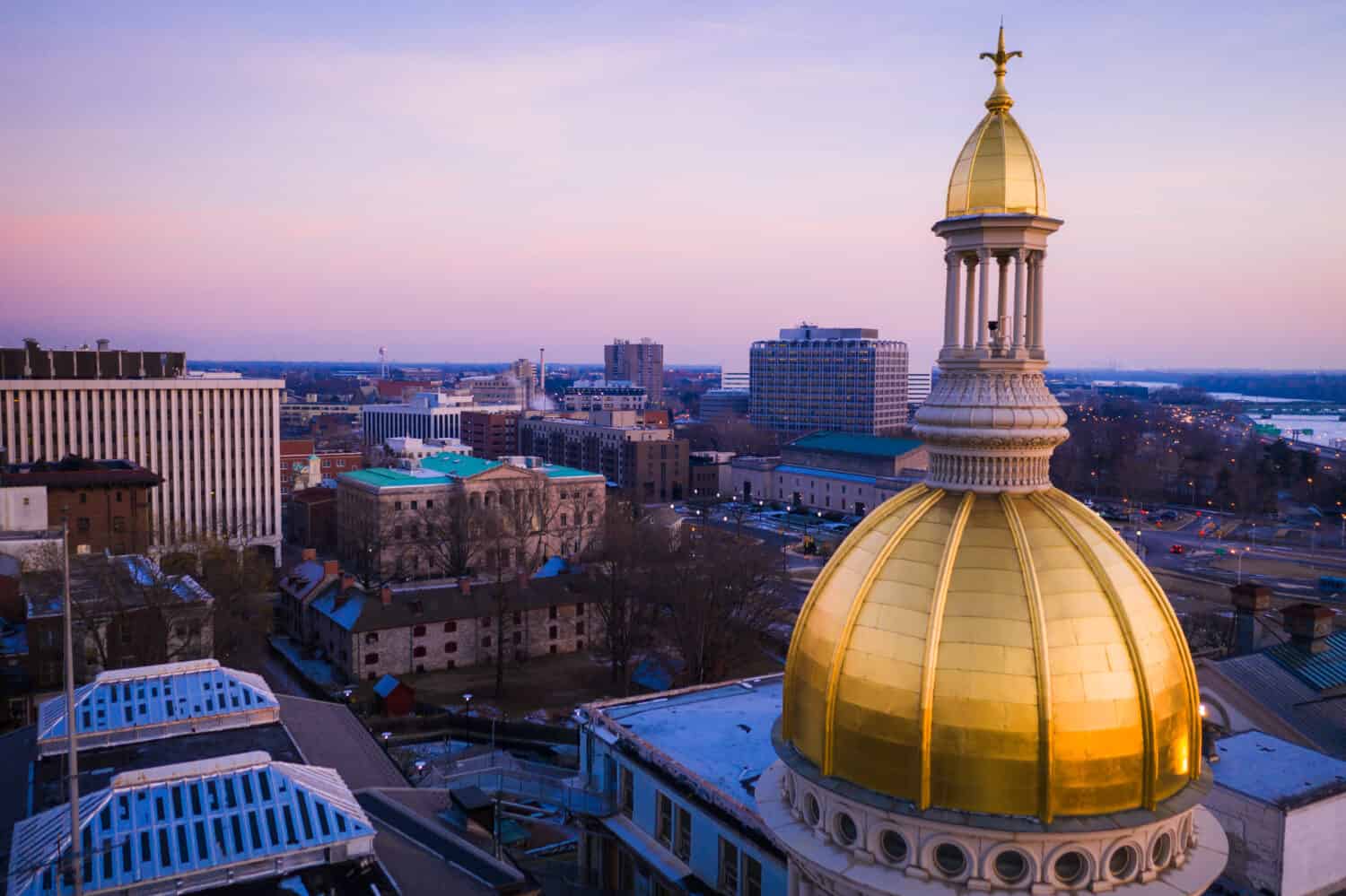One of New Jersey‘s nicknames is “the Garden State.” This name made sense in the 18th and 19th centuries when the state was mainly rural. But if all you’ve ever seen of New Jersey is the view from the highway, you might think it a strange name for such an urbanized state. In this article, we explore five of the oldest cities in New Jersey. These cities got their start when the state was truly untamed wilderness.

Though much of New Jersey is urban today, parts of it still fit the description of “the Garden State.”
1. Jersey City, 1630 (pop. 292,449)
History of Jersey City
What is today Jersey City began as a series of Dutch settlements around 1630. These were later consolidated into the Town of Jersey and later renamed Jersey City. The city is located close to New York City and includes most of Ellis Island. Because of its close relationship with NYC, people sometimes refer to Jersey City ironically as the 6th borough of New York City. Because Jersey City was a major port of entry for settlers passing through Ellis Island, it has become one of the most ethnically diverse cities in the world.
Attractions of Jersey City
Jersey City is not just a place to pass through on your way to New York. It is an exciting destination in itself.
- Visit ethnic restaurants and cultural centers for some of the hundreds of different cultures represented there.
- The Colgate Clock is the largest in the world. Built in 1924, it is 50 feet in diameter and the minute hand alone weighs 2,200 pounds!
- The empty Sky – 9/11 Memorial frames the sky space that once held the Twin Towers of the World Trade Center.
- Jersey Girls Food Tours provides tour guides who take guests on walking food tours of four to six establishments. These range from formal meals to informal samples.

The Jersey City skyline offers the same exciting urban flavor as neighboring New York City.
©iStock.com/SeanPavonePhoto
2. Elizabeth, 1664 (pop. 137,298)
History of Elizabeth
Elizabeth is next to Newark and connects by bridge to Staten Island. English settlers purchased land from the Lenape Native Americans to build the community of Elizabethtown, later shortened to Elizabeth. Surprisingly, it was actually not named for Queen Elizabeth I, but for the wife of one of the original proprietors of the New Jersey Colony. It was the first English-speaking community in the colony, and its first capital. Today it is a residential community with a mixture of urban and suburban housing, mainly rental properties. In 2008, Popular Science magazine voted it one of America’s 50 greenest cities – appropriate for a city in the Garden State.
Attractions of Elizabeth
Here are some of the attractions Elizabeth has to offer visitors:
- The city has a lot of monuments and memorials to events and people in the Revolutionary War.
- Jersey Gardens Mall is the state’s largest outlet mall with large numbers of stores, restaurants, and an amusement park.
- The Ritz Theater historic site is a historic entertainment venue that is today a performing arts center. Iconic comedians like George Burns, Jack Benney, and Rodney Dangerfield performed there.
- The city has 46 parks, trails for biking and hiking, an ice rink, fishing piers, and marinas.
- Elizabeth has several festivals, contests, and waterfront events during the year, including the Tour de Elizabeth bike tour around the city and the Elizabeth Latin Carnival.

Elizabeth, New Jersey has numerous historical monuments dedicated to Revolutionary War events.
©FotosForTheFuture/Shutterstock.com
3. Newark, 1666 (pop. 311,549)
History of Newark
Puritans from Milford, Connecticut founded Newark in 1666 on land purchased from the Hackensack Indians with guns and trade goods. As a religious community, the city’s founders were inspired by the “Ark of the Covenant” in the Bible, a golden box representing God’s presence. Thus, the name Newark literally means “New Ark.” The city eventually grew into a manufacturing powerhouse. By 1870 it was producing 90% of the country’s leather goods. The first commercially successful plastic, Celluloid, was manufactured there for use in billiard balls, dentures, and carriage parts. Today, Newark continues to innovate and lead in the new technology industry. Audible, Amazon, Panasonic, and WebMD all have a presence there. The city is the main container ship facility for seaborne trade to and from New York City and the entire Northeast.
Attractions of Newark
These are some interesting things to see and do in Newark:
- Thomas Edison National Historical Park is the site where one of the world’s greatest inventors tested audio recordings, phonographs, batteries, and film cameras. You can see his instruments, set up similarly to how he used them, and examples of the cutting-edge technology of his day.
- Newark Museum, established in 1909, is the largest museum in the state. It has an impressive collection of global artwork and natural science exhibits.
- Military Park, in the shape of a triangle, was a training area for soldiers from 1667-1869, when it was the town commons. Today it has a “Wars of America” memorial created by Gutzon Borglum, the sculptor of Mount Rushmore.
- Prudential Center draws tourists and locals for entertainment ranging from hockey games, concerts, children’s programs, and even monster truck rallies.

Newark, New Jersey is where Thomas Edison did much of his groundbreaking technological research.
©Mihai_Andritoiu/Shutterstock.com
4. Burlington, 1677 (pop. 7,743)
History of Burlington
Burlington was founded by English Quakers on land purchased from the Lenape Native Americans. Lenape chief, Ockanickon, a loyal friend to the settlers, was buried in the cemetery of the Quaker meeting house. The city developed industries in shipbuilding, bricklaying, carpentry, and shoe manufacturing. The city is the home and namesake of Burlington Coat Factory, specializing in coats and other apparel.
Attractions of Burlington
- Historic Burlington Antiques and Art Emporium offers 14,000 square feet of furniture, art, and clothing. Some pieces date back to the 18th century. This site alone makes Burlington well worth a visit!
- The Hutchinson-Revell House is one of the oldest houses in the state, having been built in 1685. Benjamin Franklin stopped here often on his travels.
- Burlington Island was inhabited up to the 1900s but today is deserted. Visitors can paddle around the island, enjoy scenic views, and spot birds and other wildlife.
- The James Fenimore Cooper House was the home of the author of an American literary classic, The Last of the Mohicans.

Burlington, New Jersey was a favorite stopping point for Benjamin Franklin on his travels across the state.
©FotosForTheFuture/Shutterstock.com
5. Trenton, 1679 (pop. 90,871)
History of Trenton
Trenton is the New Jersey state capital and is centrally located. It was founded by English Quakers and named “Trent-Towne” after one of the founders. This unwieldy name was later shortened to Trenton. Due to an outbreak of yellow fever in Philadelphia, the national capital, the federal government moved its operations to Trenton temporarily for the last two months of 1784. It was considered as a possible permanent location for the capital, but the southern states insisted on a capital below the Mason-Dixon line. Trenton was the site where George Washington crossed the Delaware River and scored his first victory against the British in the Revolutionary War. Over the years, Trenton developed a lot of interesting ethnic neighborhoods and cultures. The Italian, Hungarian, and Jewish communities were especially well represented there.
Attractions of Trenton
With its history dating to colonial days, Trenton has plenty of interesting attractions:
- Cadwalader Park is the biggest park in Trenton, at 109 acres. The same landscape architect responsible for the design of Central Park in New York City created the plan for Cadwalader Park.
- William Trent House, built in 1719, was the home of one of the city’s founders and its namesake.
- Trenton Battle Monument marks the site of the Battle of Trenton with a statue of General Washington.
- Old Barracks dates to 1758. At different times the British Army and the American Continental Army used it. It is the last colonial barracks remaining in the state.
- New Jersey State Museum is the place for you if you like archeology, ethnography, fine art, and natural history.

Trenton is the state capital of New Jersey and it once served as the national capital for two months.
©FotosForTheFuture/Shutterstock.com
New Jersey: Gardens and More
As you can tell, New Jersey has its share of green spaces, wildlife parks, hiking and biking routes, and rivers and lakes to enjoy the outdoors. It also has cities so old they predate the country itself and connect with the indigenous inhabitants of the continent. So, if you’re looking for a family trip to satisfy multiple interests, this state is a great choice.
Thank you for reading! Have some feedback for us? Contact the AZ Animals editorial team.







